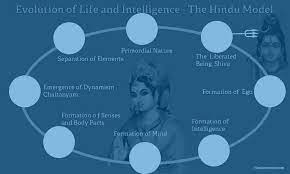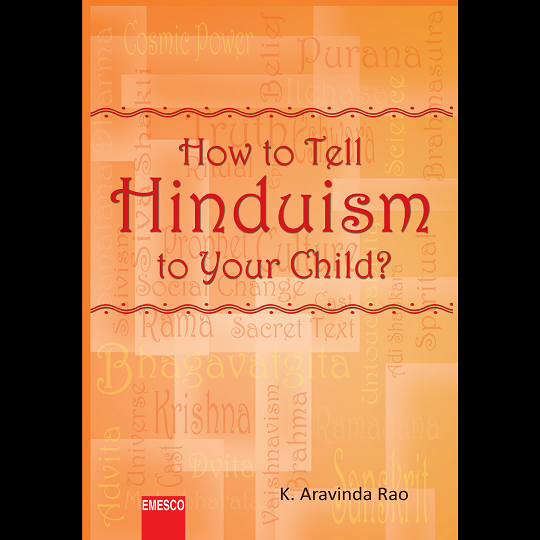(…..Continued)
Hinduism – Evolved from a Philosophical Base
What distinguishes the Vedanta philosophy from all other philosophies is that it is at the same time a religion and a philosophy. –Max Muller
Our Interface with Religion: When we go to a temple we have the priest chanting some prayers, breaking a coconut which we offer and giving us some delicious snack which was earlier offered to the god. The priest chants prayers which are composed in Sanskrit which most of us do not know. (Sanskrit was once known to everyone in society and hence the prayers were in Sanskrit). We go to different temples and see priests chanting different prayers. We do not know what the prayers mean but we have a good feeling of listening to some awe-inspiring sounds and an impressive ritual. We hardly realize that the prayers contain deep philosophical ideas.
Religion can be presented in two ways.
1) It can be told as a myth about the God, the demons (Satan, as called in western religions), heaven, hell and related structures. The god has given some commandments and one has to obey. This will satisfy an innocent believer.
2) Religion can be an honest enquiry about the nature of Supreme Being. We have to keep in mind that it is the Hinduism – Evolved from a Philosophical Base – man who is trying to know what is god. For that we have to know how far our instruments of knowledge are useful. The instruments we have are the five senses and the mind which coordinates them. Someone who
wants to propose a religion has to keep this in mind and postulate an idea of god, demons, heaven and hell.
If we look at the world religions, a majority of them fall under the first category. Religions have a sacred book which is said to contain the word of god. All people have to obey unquestioningly.
There can be description of heaven with gold pavements, fabulous mansions and heavenly damsels. In contrast, there is a dark dungeon with hellish fires to punish the non-believers.

Hinduism approaches this subject at two levels, as I said above.
1) At the level of philosophy it talks of the human being (all living beings in general) and his senses and mind. In an episode in Taittiriya Upanishad, a son goes to his father (who is a sage) and asks him to tell about the Supreme Reality. The father says – ‘you have got a body with flesh
and blood, the five senses and mind. You have also got the vital force which is enabling the body to live. Meditate on these and try to know truth’. The son starts thinking about them and finally arrives at the truth. We shall see in a later chapter. The idea here is to show that the sages had a logical approach to reality.
2) At the level of common man the sages did not prescribe a single belief system or mode of worship to a single deity. Whatever human mind can conceive is only a partial truth, says the Kena Upanishad. No one can say ‘this is what is God, this is the way heaven is’. Hence the sages permitted different modes of worship which are all accepted as tentative or interim level of truth. This is the reason we find several gods being worshiped. We will see more about this in a later chapter.
No Single Prophet in Hinduism
Hinduism was not propounded by a single prophet. It did not originate in troubled times. There was no political power enforcing it and suppressing dissent. The basic texts like the Vedas evolved over a period of a few centuries. Sages who renounced the world and speculated over the mysteries of the universe have given to us certain observations or ‘revelations’ in the form of
Vedas. These books talk about both religion and philosophy.
The Vedas thus talk at two levels, as we learnt. From the point of an ordinary man, they tell about various rituals and the fruit of such rituals. The common man is happy with them. At
some point of time people start wondering about the nature of god. Vedas talk about the second level too. The end portions of the Vedas are totally devoted to this. The uniqueness of Vedas is
that both philosophy and religion are described in the same texts by the same sages. They took a comprehensive view of society and addressed persons of different maturity levels.
Religion and belief system are accepted as a lower level of truth or empirical reality (vyāvahārika satyam) for the purpose of social guidance and harmony. Logical contemplation on
the nature of reality is accepted as the absolute level of truth (pāramārthika satyam). The latter was told to persons trained in rigorous self-discipline, while the former was for everyone. Most
people are usually happy with the lower level, conducting rituals, seeking boons from different gods and seeking forgiveness. Very few are normally seen to be bothered about the higher level of truth.
This book, of course, tries to give a simple account of this philosophical stuff, as that is the only way we can answer the questions of skeptics. Questions about religion will be discussed
in greater detail. (to be concluded)






